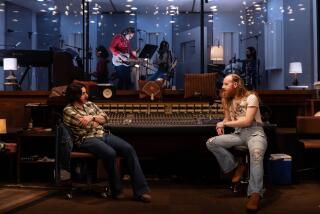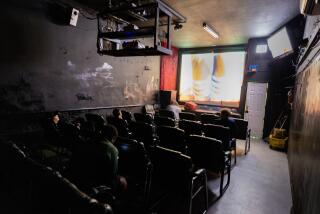A New Day Dawns for El Portal : Actors Alley Wins Battle of Red Tape as FEMA Grants $1.5 Million for Renovation
The Northridge earthquake cracked open the ceiling of the El Portal Theatre. It sent the chandelier and asbestos crashing to the floor. It shook decorative sconces off the walls. But it left the letters on the outdoor marquee in place--and that was all it took to convince an inspector from the Federal Emergency Management Agency that the theater shouldn’t get federal aid.
“The Male Animal,” the marquee read.
Porn, the inspector thought, obviously unfamiliar with the play by James Thurber and Elliot Nugent.
That anecdote--though unfamiliar to FEMA officials--is already part of the mythology surrounding El Portal’s comeback. True or not, the story is symbolic. It foreshadowed multiple setbacks that would beset Actors Alley, the troupe that operates the theater.
But there is a happy ending in sight. On Jan. 13, FEMA approved a $1.5-million grant, enough to complete El Portal’s transformation from decaying movie house to theater center. All it took was two years of trudging through the bureaucratic bog of FEMA.
Bob Caine, Actors Alley’s managing director, said FEMA employees were doing everything they could to help. “But we didn’t fit a mold,” he said, standing in the cold, cavernous theater. “And that’s difficult for any agency to deal with.”
What made the drawn-out process more frustrating for Actors Alley was the fact that when the temblor struck on Jan. 17, 1994, the troupe was less than three weeks from its grand opening at El Portal--the linchpin of the NoHo Arts District.
The group had moved into the 70-year-old movie palace the year before and, with a loan from the Community Redevelopment Agency, was converting it into three theater spaces. Only the 360 new seats, which hadn’t been installed, were spared from earthquake damage.
Actors Alley couldn’t afford to be patient; small theaters in the Valley open and close with the seasons. If the troupe was off the map too long, it would be written off for dead. Rather than cancel the 1994 season, the actors put on plays in a tent across the street.
Last spring, the troupe moved into the smallest of the three planned theaters, the 49-seat Storefront, for its 1995 season. The actors will remain there for the recently announced 1996 season, which begins in April with the comedy “Marvin and Mel.” Currently the troupe is producing a free festival of one-act plays.
*
After the quake, Actors Alley took out another loan from the Small Business Administration, and applied to FEMA for money to rebuild. FEMA inspectors--used to dealing with medical clinics, schools and social service offices--didn’t know what to make of the crumbling theater.
The toughest question was whether Actors Alley was even eligible for a FEMA grant. Actors Alley first had to prove that its outreach programs for young people and senior citizens made it a “nonprofit community center.” Then, eligibility became a question of interpretation: Some federal guidelines said the organization must “own and operate” the building, while others said “own or operate.”
Steve Rothman, whom Actors Alley hired as a restoration consultant, said that every time they thought the grant was guaranteed, things would dissolve. They had Rep. Howard L. Berman (D-Panorama City) and his staff prodding FEMA. Still, months would pass with no word from the agency.
“Because FEMA is an emergency organization, there were a lot of personnel changes,” Rothman said. “Just when we would feel like we’d come to an agreement, that person would be rotated someplace else and we’d have to start all over again with someone new.”
That’s a valid criticism, said Leland Wilson, the FEMA federal coordinating officer who oversees the Northridge earthquake recovery. When a disaster strikes, he said, FEMA rushes in emergency staff from all over the country. The agency eventually hired longer-term local employees, but not before another generation of temporary staff filed through the office.
The whole thing should have been settled within a year, Wilson said. It wound up taking more than 18 months.
But it wasn’t just FEMA taking up time. Because federal money might be used on El Portal, the building had to meet the Department of the Interior’s guidelines for historic buildings. Even after reports showed that the extensive damage would keep the building off the historical register, Caine said, they spent time--and money--preserving what they could of the atmosphere in the Valley’s oldest remaining theater.
For example, the front piazza--complete with antique ticket booth--and the original marquee will remain.
The marquee is currently covered by a sign announcing that the Circle and Pavilion theaters will open in January-February 1996. More likely, it will be 1997. Rothman is shooting for Jan. 17--the third anniversary of the earthquake.
There’s a lot to be done between now and then. The 360-seat Pavilion theater has no electrical wiring. The walls, which still contain asbestos, have to be sealed off. A thrust stage has to be built adjacent to the proscenium. Panels that adjust for sound and lighting need to be installed in place of a ceiling.
FEMA is making some changes, too, including tightening up the eligibility requirements for nonprofit groups. Wilson said, “So many community centers (applied) that we said, are these really community centers? What do they offer that is an essential governmental service? And should this be continued in the future?”
Most of the groups that received grants this time, including Actors Alley, will be ineligible if there’s another disaster.
But for now, the Actors Alley crew is basking in its success as if it were already opening night. Deep down, Rothman said, he always knew FEMA would deliver. It’s like putting on a play, he said. There are pitfalls you don’t expect, but it comes together.
“Every element of theater is looked at as a little miracle,” Rothman said. “Now we’re all sitting around and smiling so much. We’re in sort of a state of bliss.”
If FEMA had ultimately rejected Actors Alley, Caine said they would have stayed at El Portal, but it would have taken years to raise enough money to reach their goal of being the regional theater for the Valley with a full season of Equity-contract plays.
But no one ever seriously considered breaking up Actors Alley, Rothman said. Even in their darkest moments, he recalled, “Everyone said, ‘No way. This is a 25-year-old theater [group]. We can’t let the building kill the institution.’ ”
DETAILS
* WHAT: “An Evening of One-Acts and More,” including “Inside Out” by Tom Coasch, “Poor David’s Landing” by Frederick Combs, and “Health” by Tom Scanlon.
* WHERE: Storefront Theatre at El Portal, 5269 Lankershim Blvd., North Hollywood.
* WHEN: 8 p.m. Friday, Saturday and Sunday.
* HOW MUCH: Free.
* CALL: (818) 508-4200 for reservations.
More to Read
The biggest entertainment stories
Get our big stories about Hollywood, film, television, music, arts, culture and more right in your inbox as soon as they publish.
You may occasionally receive promotional content from the Los Angeles Times.










